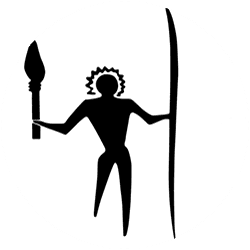Massim Betel-Nut Mortar
A decorated betel-nut mortar for crushing betel nut. The inverted conical bowl is carved out of the uppersection while the lower end is carved of pedestal form enabiling the the mortar to stand on it is own. The central section is carved to one side with a highly stylized cubistic face with pig-tail curliques to either side of the mouth. A band of zigzag is carved as if to represent a wide belt with the figures genitals appearing from underneath. Massim Region, PNG, Melanesia. Wood, stone carved with remains of lime highlights and betel nut patination. 19/20th century. 20,8 x 6,2 cm.
Provenance Collected in the field by Harry Beran and Anthony JP Meyer in 1987.
Literature: Ref. Beran, Harry: MASSIM TRIBAL ART-PAPUA NEW GUINEA. Wollongong City Gallery, Wollongong. 1980. Beran, Harry: BETEL CHEWING EQUIPMENT OF EAST NEW GUINEA. Shire Ethnograhy, Bucks, 1988. Meyer, Anthony JP.: LE PAYS MASSIM-PAPUA NOUVELLE GUINEE. Catalogue d'exposition. Galerie Meyer, Paris. 1987.
The term Betel Nut is a missnomer. The nut is the fruit of the areca palm (Areca catechu), known as buai in the Massim language. However, is not a true nut, but rather a fruit categorized as a berry.
The Areca “nut” is chewed with the peppery tasting betel leaf (Piper betle) and powdered slacked-lime (calcium hydroxide) as a mild stimulant, causing a warming sensation in the body and slightly heightened alertness, although the effects vary from person to person all the way to an extreme alteration similar to that provoked by alcohol intake.
The nut is used in dried, cured (smoked), and fresh forms. When the husk of the fresh fruit is green, the nut inside is soft enough to be cut with a typical knife or with the teeth. In the ripe fruit, the husk becomes yellow or orange, and as it dries, the fruit inside hardens to a wood-like consistency. At that stage, the areca nut cannot be chewed but must be crushed in a mortar.
The areca nut contains the tannins arecatannin and gallic acid, a fixed oil gum, a little terpineol, lignin, various saline substances, and three main alkaloids : arecoline, arecaidine, and guvacine - all of which have vasoconstricting properties. The betel leaf chewed along with the nut contains eugenol, another vasoconstrictor.










